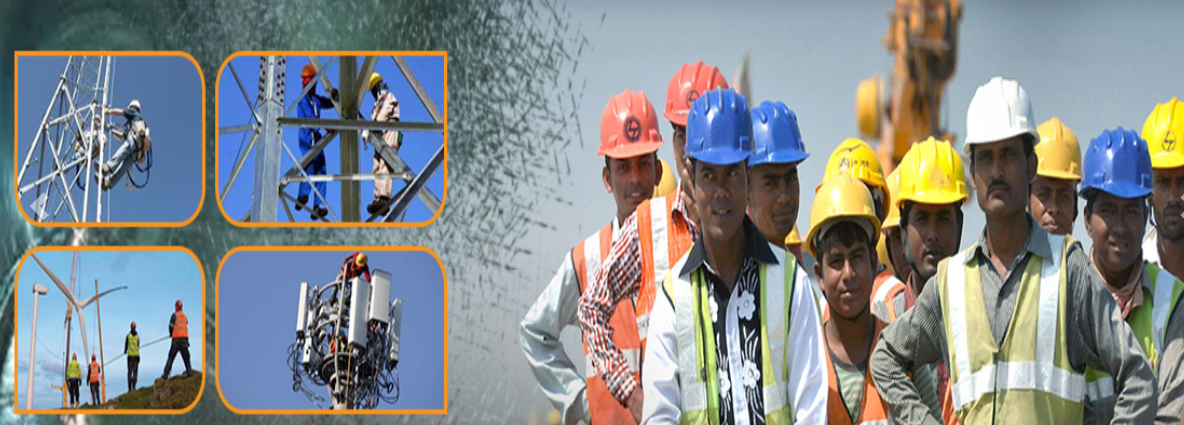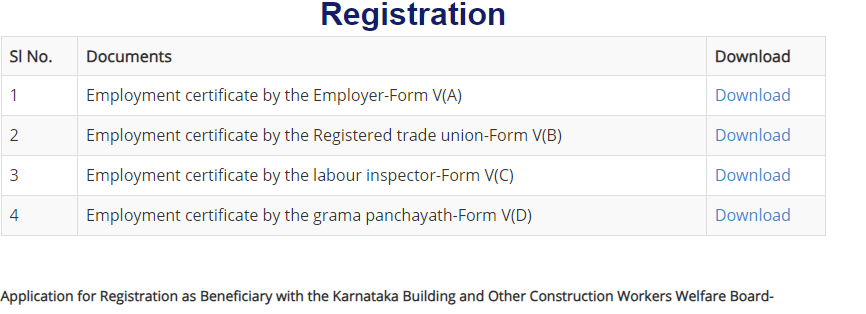Step 1: Getting the labour card
What is BoCW labor card?
A BoCW labor card is an official identification card issued to construction workers who are eligible under the BoCW Act.
Why is the possession of a labor card from BoCW mandatory for construction workers?
In Karnataka, Possession of a labor card from the Building and Other Construction Workers (BoCW) is mandatory for construction workers for several key reasons:
-
Registering construction workers for welfare benefits.
-
Providing financial aid for education, healthcare, maternity, disability, etc.
-
Promoting skill development for better job prospects.
-
Offering social security benefits like pensions and insurance.
-
Implementing government schemes for worker welfare.
-
Providing legal support for employment rights and benefits.
-
Ensures quick identification and assistance for workers during emergencies.
These reasons underscore the significance of labor cards in regulating and supporting the construction workforce, ensuring their rights, safety, and welfare, and promoting the efficient functioning of the construction industry.
To obtain a BoCW Labor card, what are the necessary mandatory documents required?
- Employment certificate- to prove work in B&OC for 90 days in the preceding year
- Aadhaar Card (with linked mobile number)
- Ration card (now not mandatory, till 6 months ago was mandatory for renewal)
- Age proof (e.g., Voter ID or Aadhaar)
- Nominee and children's correct name and age details
What is the process to get a 90-day employment certificate?
First Click on the “Click here to download Employment certificate template.”
Click here to download Employment certificate template.
A pop-up containing the list of 90 days working certificates will be shown.
Labour can then click on the download option to download the required 90 days working certificate based on the issuer of the certificate.
90's days work certificate template page
Which four authorities issue 90-day work certificates?
- Labour Inspector
- Employer
- Registered Labour Union
- Gram panchayat
What are the eligibility criteria for obtaining a BoCW labor card?
- Labour has worked 90 days in BoCW
- Construction worker should age between 18-55
-
Exclusively construction laborers (excluding positions such as mason, plumber, electrician, etc.), with roles like those assigned to parking areas or gardening, are not considered as construction worker.
Key factors for obtaining a labor card for construction workers: Critical and enabling factors.
|
Benefits |
Amount (Rs.) |
Frequency |
Applies to |
Contribution by worker (Rs.) |
Time specified (days) |
Time taken (days) |
Fee specified (Rs.) |
Money spent (Rs.) |
Timeline for submission |
|
BOCW Card |
- |
- |
BoCW Worker |
- |
45 |
60-90 |
50 |
|
After 90 days of work in B&C |
Why do construction workers often fail to receive the benefits they are entitled to from various schemes?
Potential factors leading to exclusion from the benefits of schemes under BoCW at different phases
Lack of awareness and trust among workers-
-
Workers who have been here for 20 years don't know about their entitlements.
-
Applicants are reluctant to share all docs/ information with CSOs. This is especially true for recent migrants.
- Once application gets rejected there is no refund. So, workers are apprehensive of wasting money and go via agencies.
Lack of supporting documents-
- Many times workers leave their necessary documents at native place when they come for work, especially migrants from UP & Bihar
- Having a bank account with an Aadhar-linked mobile phone is a prerequisite, and many workers do not meet this requirement
- Names, age and address don’t match in different docs
Lack of resources-
-
Lack of access to smart phones and in many cases a single phone number used by multiple members of the household. With a single phone number, if both father and son are laborers, only one gets the benefit albeit both have phone linked Aadhaar cards.
- In certain instances, workers' essential documents are kept at their hometowns, and their families there do not possess smartphones to send images of necessary documents, such as Aadhar cards, ration cards, PAN cards, and bank passbooks
-
Workers often change their phone numbers frequently, and their Aadhar numbers may not be linked to their current phone numbers
Lack of cooperation-
Policy design issues-
On-ground implementation issues-
-
Gardeners, parking area employees etc. roles not considered CW (trades like mason, plumber, electrician etc. are considered part of CW).
-
Mainly with respect to pension, registration should be done before the age of 55.
-
Labour should be registered as a laborer with the District Labour Office in his/her circle area.
- Petty labourers don’t get the seal/ sign of contractors as they work irregularly at different site
- Physical verification of hands to figure out person is working sand and cement
- At the time of verification, worker may switch to another worksite hence not available on previous construction site when he applies
- Petty labourers don’t get the seal/ sign of contractors as they work irregularly at different sites
-
Another example: a person drives a vehicle supplying water on construction sites. When the labour inspector calls for verification, he says I am a driver. So, the application gets rejected.
Tech related
- BOCW website doesn’t stay up for more than 10 minutes at a stretch- it frequently takes them 5 hours to fill one application form
- Technical glitches like photo size and space also pose an important challenges while uploading docs
- Some CSOs take money from applicants to apply for cards/ schemes
- Cyber centres bribe officers to get work done
- For all Aadhaar linkage work, OTP comes to the applicant’s phone but they refuse to cooperate because they are at work or don’t see phones for a long time. So this application process needs to be repeated multiple times as OTP has time-bound validity.
- Workers don’t remember the login details which remain with CSOs, so trust building takes time.
Documents-
-
Name, age and address don’t match in different documents.
-
Requires dedicated bank account passbook; many workers lack a bank account and not carrying bank passbook.
Aadhar seeding-
-
Aadhar-mobile link mandatory, but worker's frequent number changes cause repeated linking.
-
Single mobile number for many individuals.
-
No Android phone hampers remote Aadhar copy sharing, if cards at hometown.
-
Weak network or on-site work delays OTP receipt.
-
Hard labor affects accurate bio-metric fingerprints.
Registration process-
-
Most laborers unaffiliated with CSOs, often resort to costly cyber-cafés; rejections lead to money loss, discouraging scheme registration.
-
Cyber center also bribes officers to get work done.
-
Workers don’t remember the login details which remain with CSO.
-
Once application gets rejected there is no refund. So, workers are apprehensive of wasting money and go via agencies.
Annual Renewal-
-
Muster roll or pay slip is required- not possible to obtain for ‘gig’ workers within CW. Trade unions can provide work certificate for 90 days but cannot provide muster rolls.
-
Dept is not accepting renewals w/o muster roll because many non-construction workers have enrolled. They are awaiting new format of muster rolls from the dept now. Workers with big builders don't have a problem.
-
Physical verification of hands to figure out person is working with sand and cement.
-
At the time of verification, worker may switch to another worksite hence not available on previous construction site when he applies.
-
Labour card is to be renewed every year/ every 3 years- workers don't keep track and delay in renewal means they lose access to benefits.
Tech/ website related-
-
BOCW website doesn’t stay up for more than 10 minutes at a stretch- it frequently takes them 5 hours to fill one application form.
-
Technical glitches like photo size and space also pose an important challenge while uploading documents.
What measures does the CSO undertake to offer resolution to laborers regarding matters related to the BoCW labor card?
- Certain CSOs enroll construction workers into unions, and these unions assume the comprehensive responsibility for addressing labor card issues, including renewal, corrections, and updates, such as Sampark and Grakoos.
- Mitr Sanketa, which primarily serves domestic workers but also offers assistance to construction workers, showcasing a broader commitment to supporting various segments of the informal sector.
- Mitr Sanketa takes an additional step by liaising with government departments to personally collect the paperwork required for laborers' card applications and access to various schemes.
- Jansahas is an example of a CSO that underwent a qualifying test to obtain the license for Seva Sindhu, the government portal used for registering laborers, updating their Aadhar information, and applying for various schemes. This was achieved by establishing a community service centre.


